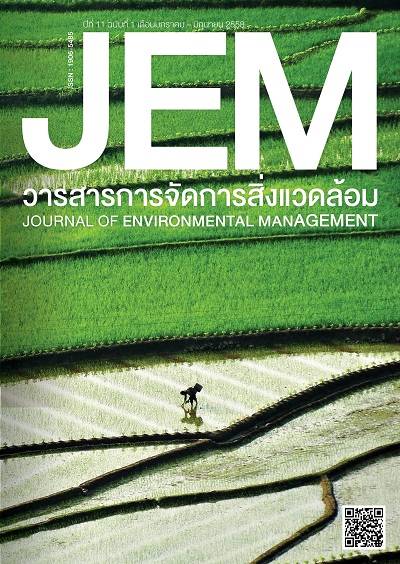การส่งเสริมการจัดการมลพิษทางน้ำโดยชุมชน Promotion of Community-Based Management of Water Pollution
DOI:
https://doi.org/10.14456/jem.2015.1บทคัดย่อ
บทความนี้มีวัตถุประสงค์เพื่อถอดบทเรียนการบริหารจัดการน้ำเน่าเสียในแหล่งน้ำโดยชุมชนในประเทศไทย โดยอาศัยกระบวนการทบทวนเอกสารที่เกี่ยวข้อง การหามิติของประเด็นสำคัญ การสัมภาษณ์เชิงลึกผู้เชี่ยวชาญที่เกี่ยวข้องและการจัดสัมมนา นำข้อมูลที่รวบรวมมาวิเคราะห์จุดแข็ง จุดอ่อน โอกาสและอุปสรรค เพื่อให้ได้รูปแบบที่เหมาะสมต่อการจัดการน้ำเน่าเสียและสามารถนำไปปฏิบัติได้ ผลการศึกษาทำให้ได้แนวทางการแก้ไขปัญหา ซึ่งสามารถแบ่งออกเป็นระยะสั้น (ช่วงที่เกิดน้ำเสีย) ระยะกลาง (ภายใน 3 ปี) และระยะยาว (เกิน 3 ปี) ทั้งนี้ แนวทางในการแก้ปัญหาในเชิงนโยบายจะเกี่ยวข้องกับการปรับปรุงระเบียบ กฎหมายและนโยบายให้เอื้อต่อการจัดการน้ำเสีย ปรับปรุงบทบาทของท้องถิ่นให้มีความเข้มแข็ง สามารถจัดการระบบภายในท้องถิ่นได้อย่างอิสระและจัดเก็บค่าบริการได้อย่างเหมาะสม โดยกำหนดให้มีองค์กรร่วม 3 ฝ่าย ได้แก่ ชุมชน สถานประกอบการและภาครัฐในการร่วมเฝ้าระวัง กำกับดูแล ป้องกันรักษาให้เป็นไปตามมาตรฐานที่ปรับปรุงแล้ว โดยให้กำหนดคุณภาพแหล่งน้ำและมาตรฐานน้ำทิ้งจากแหล่งกำเนิดต่างๆ ให้เหมาะสมและทันต่อเหตุการณ์ และให้พิจารณาการจัดตั้งกองทุนสิ่งแวดล้อมให้สามารถบังคับใช้ได้อย่างมีประสิทธิภาพ ในขณะที่การปฏิบัติจะเกี่ยวข้องกับการจัดทำแผนร่วมกัน การฟื้นฟูและอนุรักษ์แหล่งน้ำ การประสานระหว่างหน่วยงาน การบังคับใช้กฎหมายอย่างจริงจัง การเรียนรู้ เข้าใจในปัญหาและวิธีการรวมทั้งการสร้างแรงจูงใจให้ประชาชนและองค์กรส่วนท้องถิ่นได้มีส่วนร่วมในการแก้ปัญหา
This article investigates the management of water pollution by local communities. The methodology is based on a review of documentation, finding the dimensions of the main points, and in-depth interviews with experts and seminars. The collected data were analyzed to determine the strengths, weaknesses, opportunities, and threats in order to obtain the proper model so that management of water pollution by the public can be achieved. The results reveal measures for solving the problems, which can be divided into short-term (problem occurring), medium-term (within 3 years), and long-term (more than 3 years) measures. Regarding policy, the solutions are associated with improvement of laws and policies to facilitate the management of waste water. This should enable the role of local inhabitants to be strengthened, for them to be able to freely handle their problems, and to charge an appropriate fee. This will lead to the establishment of an environmental fund and public-private-community partnership involved in the joint activities of surveillance, pollution prevention, and treatment according to revised regulatory standards. The quality of water resources and the effluent from various sources should be determined appropriately and relevant data/information should be kept up to date. In practice, the solutions are associated with the plan involvement, the restoration and conservation of water resources, the coordination between agencies, law enforcement, learning and understanding of the problems and methods, and motivation to encourage people and local organizations to take part in the solution.
เอกสารอ้างอิง
Appelgren, B. (2004). Water and ethics: water in agriculture. Essay 5. Paris: UNESCO.
Brenner, T., Buijse, A.D., Lauff, M., Luquet, J.F. & Staub, E. (2003). The present status of the River Rhine with special emphasis on fisheries development. In R. L. Welcommes & T. Petr (eds.), Proceedings of the Second International Symposium on the Management of Large Rivers for Fisheries: Vol. 1, RAP Publication 2004/16. Bangkok: Food and Agriculture Organization.
Chertchom, P. & Wongkamolserd, S. (1994). Systems Analysis [In Thai: การวิเคราะห์ระบบ]. Bangkok: Siam Sport Syndicate.
Jaiswal, R.K. (2007). Ganga action plan–A critical analysis. ECO Friends for environmental education, protection & security, India.
Lee, S. (2006). China’s water policy challenges. Discussion paper 13. China Policy Institute, University of Nottingham, UK.
Narasimhan, T.N. (2008). Water, law, science. Journal of Hydrology, 349, 125 – 138.
Pimentel, D. & Pimentel, M. H. (2008). Food, energy, and society. Third edition. Boca Raton: CRC Press.
Poboon, C. (2008). Local Authority and Good Practice in Environmental Management [In Thai: องค์กรปกครองส่วนท้องถิ่นกับการจัดการสิ่งแวดล้อมที่ดี]. Full research report, School of Social and Environmental Development, National Institute of Development Administration.
Sirivilai, D. (2012). Wastewater Management for Local Authorities: A case study of Muangklang Municipality, Rayong Province [In Thai: การจัดการน้ำเสียขององค์กรปกครองส่วนท้องถิ่น: กรณีศึกษาเทศบาลตำบลเมืองแกลง จังหวัดระยอง]. Unpublished Master’s Thesis, National Institute of Development Administration.
Srithong, K. (2008). People Participation in Wastewater Treatment Plant, Sakon Nakhon Municipality [In Thai: การมีส่วนร่วมของประชาชนในการจัดการระบบบำบัดน้ำเสีย เทศบาลเมืองสกลนคร]. Unpublished Independent Studies, Mahasarakham University.
Tangkidwanich, N. (2006). Wastewater Management from Residences and Enterprises in Udon Thani Municipality Areas [In Thai: การจัดการน้ำเสียจากบ้านพักอาศัยและสถานประกอบการในเขตเทศบาลนครอุดรธานี]. Unpublished Master’s Thesis, Chiang Mai University.
[UNEP] United Nations Environment Programme (2010). Sick water? The central role of wastewater management in sustainable development. A rapid response assessment. GRID-Arendal: UNEP/UN-Habitat.
[UNFPA] United Nations Population Fund (2009). State of World Population 2009 - Facing a changing world: women, population and climate. New York: United Nations Population Fund.
[WWAP] World Water Assessment Programme (2009). Water in a changing world: The United Nations World Water Development Report 3. Paris/London: UNESCO/Earthscan.



